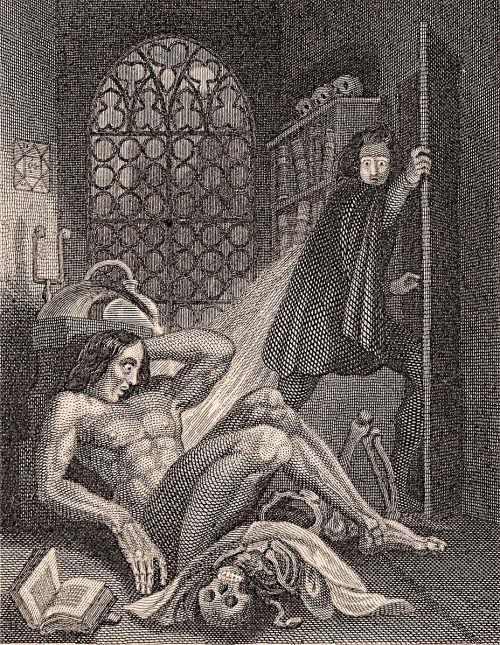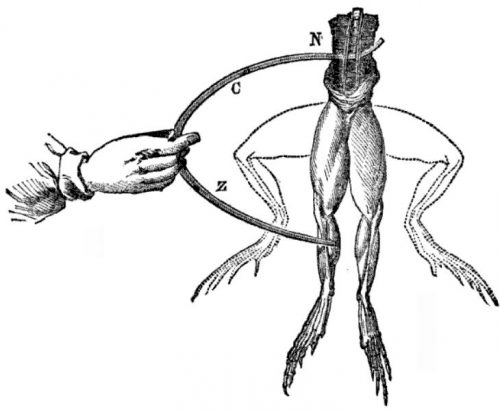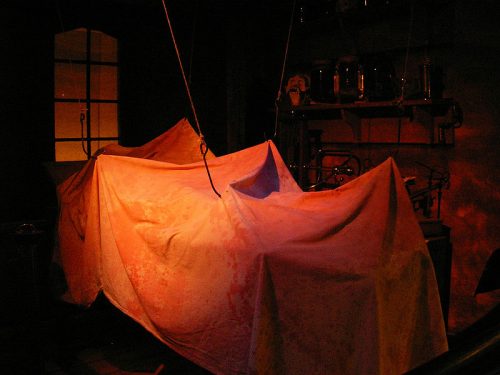
This year marks the 200th anniversary of the publication of Frankenstein. Written by a teenage Mary Shelley on a dare, this classic example of science fiction and horror explores the ethics of scientific discovery. In the story, Victor Frankenstein brings a corpse (or, many pieces of corpses sewn together) to life. Instead of continuing to study his creation, he runs away leaving it alone and defenseless. At first, the creature attempts to befriend the people he meets, but they are so offended by this specimen that they chase him away. Lonely, the creature vows to take revenge on his creator by killing Victor’s loved ones. Eventually, both the scientist and the experiment are left alone with their misery, floating off on icebergs.

Frankenstein was based on real science at the time—Galvanism—when scholars and showmen were animating dead bodies with small electric shocks. Shelley saw some of these demonstrations and, after a few rainy night’s in Byron’s castle, penned the novel. Against this bleak backdrop, Shelley asks us to consider who is responsible for the devastation in her story? Is it the creature, a mere experiment, who caused such destruction? Is it the scientist who never took responsibility for his own work? Or, could it be the people, those who shunned the scientific anomaly because they didn’t like what they saw? What happens when other people make a monster out of your work?
We are still wrestling with these questions today as we debate gender and genetics. A recent article from Amy Harmon in The New York Times reports on communities willfully misinterpreting recent research in social science and genetics to support white supremacist views. At the same time, the department of Health and Human Services is considering establishing a formal definition of gender grounded in “scientific evidence” that could curtail civil rights protections for transgender and nonbinary people—despite the fact that biological research doesn’t support this binary view.
The scariest part of these stories isn’t just that science is taken in bad faith, it is also the confusion about who is responsible for correcting these problems. From Harmon’s article:
Many geneticists at the top of their field say they do not have the ability to communicate to a general audience on such a complicated and fraught topic. Some suggest journalists might take up the task. Several declined to speak on the record for this article.
Social science research shows that trust in scientific evidence isn’t just a matter of knowing the facts or getting them right. Trust in science requires cultural work to achieve and maintain, and political views, prior beliefs, and personal identities can all shape what kinds of evidence people accept and reject. While the media plays a big role in this work, experts also have to consider who gets to control the narrative about their findings.
The bicentennial of Frankenstein asks us to consider, this hallow’s eve, the responsibility we carry as researchers, as interpreters of research, and as those who lead people to research. It is our guidepost and our warning call. This is why we (a science educator and a sociologist) both think science education and public engagement from experts is so important. If practitioners back away from the public sphere, or if they don’t intervene when people misinterpret their work, there is a risk of letting other social and political forces make them into Victor Frankensteins. What do you think? Do experts just need to stick to the science and leave their results to everyone else? Or, do scientists need to start worrying more about their PR?

Sofia Lindgren Galloway is a STEM Educator at The Bakken Museum and a theatre artist in Minneapolis. With The Bakken Museum, Sofia performs educational plays and teaches classes about Mary Shelley, Science Fiction, and the history of electricity, among other topics.
Evan Stewart is a Ph.D. candidate in sociology at the University of Minnesota. You can follow him on Twitter.

Comments 11
Phill Wagner — October 25, 2020
We cannot take on anger toward these professors. They are ensnared in a faulty worldview…Let us not blame the world for being the world…We can respond by pulling up stakes and retreating further into our sub-culture
https://expert-writers.net/
or we can be the harbingers of freedom to the captives. Our focus is to be on restoring rather than retreating.”
molliegilbert — August 25, 2021
site has a simple layout and presentation, without many frills. You have a series of profile photos and live webcam shows. You snapsext app android review consult them, scan hot images and let your imagination do the rest. You are welcome to chat with users from all over the world using the webcam chat option. There are no notable limitations in adult content here, and you may push yourself beyond the limits.
Pat Bell — February 20, 2022
Obviously, neither of these solutions is suitable; therefore, it’s time to figure out what to do in case your teacher gives you a difficult task which you don't want to accomplish. There is no doubt that coursework professional help is one such an assignment; however, a good grade will be quite beneficial in furthering your academic progress. You should definitely start looking for all available options.
nicolhill — June 19, 2022
They are drop-useless gorgeous, such hot thai women a lot of guys from America and Europe searching for online Thailand girls. They are all slim and feature wonderful our bodies and they stay this kind of healthy life with their sparkling food regimen. Thai mail-order brides like to care approximately their loved ones and are continually trying to percentage their love with the people they love.
nicolhill — August 15, 2022
Colombian women looking for marriage can https://alwaysinvitedevents.com/hot-colombian-women/ be demanding, suspicious and overly emotional. These girls are still considered one of the most feminine. This is noticeable not only in the Colombian women body but also in the way they behave. That is why they expect men to behave like real men. In Colombian dating culture, single Colombian women expected from men to prove that they can be strong and assertive leaders. Colombia girls appreciate courageous and independent partners.
anna — August 15, 2022
Colombian women looking for marriage hot brazilian women can be demanding, suspicious and overly emotional. These girls are still considered one of the most feminine. This is noticeable not only in the Colombian women body but also in the way they behave. That is why they expect men to behave like real men. In Colombian dating culture, single Colombian women expected from men to prove that they can be strong and assertive leaders. Colombia girls appreciate courageous and independent partners.
meoktwi — March 27, 2023
This is a very good post. I just want to say that I found your blog and I am very happy to read your posts about 토토사이트 . I will be subscribing to your blog and hope you write again soon.
mnuoisr — October 24, 2023
That is all the helpful information I needed. I appreciate you sharing.
Super Mario
freak picsart — March 29, 2024
Picsart's image enhancer is simply phenomenal! It effortlessly enhances my photos, bringing out vibrant colors and stunning details. Truly a must-have feature!"
picsart — April 19, 2024
Picsart's image enhancement tools allow you to transform your photos into stunning visuals with ease. Elevate colors, clarity, and creativity effortlessly!
Annata Evan — June 5, 2024
When science ventures into unknown Pokerogue territories or delves into controversial topics, it can indeed evoke fear and uncertainty among the public.